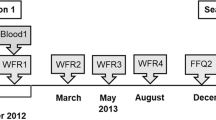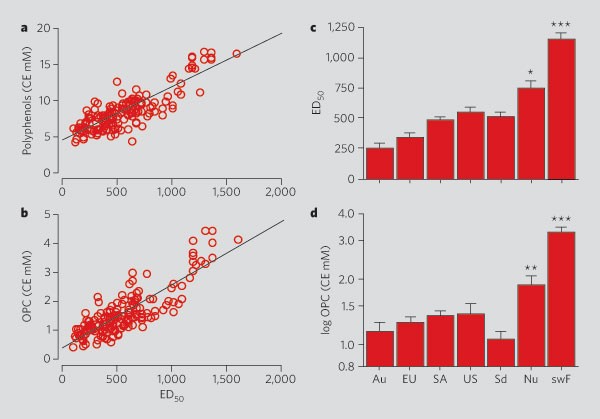Abstract
Regular, moderate consumption of red wine is linked to a reduced risk of coronary heart disease and to lower overall mortality1, but the relative contribution of wine's alcohol and polyphenol components to these effects is unclear2. Here we identify procyanidins as the principal vasoactive polyphenols in red wine and show that they are present at higher concentrations in wines from areas of southwestern France and Sardinia, where traditional production methods ensure that these compounds are efficiently extracted during vinification. These regions also happen to be associated with increased longevity in the population.
Similar content being viewed by others
Main
High consumption of polyphenols inhibits atherosclerosis in experimental models3,4. Red-wine polyphenols induce endothelium-dependent dilatation of blood vessels and suppress the synthesis of endothelin-1 (ET-1), a peptide that has a vasoconstricting effect5,6,7, and this may account for their anti-atherosclerotic activity. However, there is a lack of consensus on the protective effects of red wine, which may be due to variability in vasoactive constituents in different wines.
Red-wine polyphenols are a complex mixture of flavonoids (mainly anthocyanins and flavan-3-ols) and non-flavonoids (such as resveratrol and gallic acid). Flavan-3-ols are the most abundant, with oligomeric and polymeric procyanidins (condensed tannins) often representing 25–50% of the total phenolic constituents8.
We used cultured endothelial cells to identify the most potent vasoactive polyphenols in red wine (for methods, see supplementary information). These were shown by high-performance liquid chromatography with mass spectrometry2 to be straight-chain B-type oligomeric procyanidins (OPCs) (tetra-epicatechin gallate, m/z = 1,305; procyanidin trimer-gallate, m/z = 1,017; procyanidin tetramer, m/z = 1,153; and pentamer-gallate, m/z = 1,593; see supplementary information).
Total polyphenols and OPC content of each wine correlated with the suppression of ET-1 synthesis (Fig. 1a, b). However, the linear regression plot for total polyphenols intercepted the y-axis at about 5 mM, which is consistent with most polyphenols (anthocyanins, catechins and resveratrol) lacking vasoactivity at the concentrations found in wine5,7.
a, b, Total polyphenol (a) and oligomeric procyanidin (OPC) (b) content correlate with the inhibition of synthesis of endothelin-1, expressed as ED50 (dilution inhibiting by 50%; see supplementary information); R = 0.84 for both, n = 165. c, d, Comparison of inhibition of endothelin-1 synthesis (c) with OPC concentration (d) of wines from different geographical regions. Au, Australia; EU, France, Greece, Italy or Spain; SA, South America; US, United States; Sd, Sardinia; Nu, Nuoro province, Sardinia; swF, southwest France. CE, catechin equivalents (see supplementary information). ***P < 0.001 compared with all the other wines; *P < 0.01 compared with the United States, and P < 0.001 compared with the other wines; **P < 0.02 compared with the United States and South America, and P < 0.001 compared with the other wines.
To investigate how the OPC content of red wines from a particular region might relate to mortality in that region, we compared wines produced in areas of increased longevity (as an index of overall good health) with a broad selection of wines from different countries. People living in Nuoro province, Sardinia, have high longevity, particularly men9. In France, there are marked regional variations in mortality from coronary heart disease. We used the 1999 census data to identify unusual patterns of ageing in France (see supplementary information) and found that there are relatively more men aged 75 or over in the département of Gers in the Midi-Pyrenees in southwest France.
Wines from Nuoro and the Gers area have 2–4-fold more biological activity and OPC content than other wines (Fig. 1c, d). This difference remains (P < 0.001) when OPC measurements are extended to a wider selection of wines from the Gers area (2.9 ± 0.1 mM, n = 58), from France (1.8 ± 0.1 mM, n = 61) and from other parts of the world (1.5 ± 0.04 mM, n = 227).
Grape seeds are the main source of OPCs but poor solubility, combined with oenological and viticultural factors, influence the amount of OPCs in wine8. The higher OPC concentration in wines from southwest France is due to traditional wine-making, which ensures that high amounts of OPCs are extracted, and to the flavonoid-rich grape Tannat, which makes up a large proportion of grapes used to produce local wines in the Gers area but is rarely grown elsewhere.
Absorption of OPCs and their identification in plasma has been demonstrated in vivo10, but little is known about their biological availability and metabolism. Further investigation of OPC-rich wines and foods should provide insight into how vascular function might be optimally maintained.
References
Renaud, S. C., Gueguen, R., Siest, G. & Salamon, R. Arch. Intern. Med. 159, 1865–1870 (1999).
Di Castelnuovo, A., Rotondo, S., Iacoviello, L., Donati, M. B. & De Gaetano, G. Circulation 105, 2836–2844 (2002).
Kris-Etherton, P. M. & Keen, C. L. Curr. Opin. Lipidol. 13, 41–49 (2002).
Auger, C. et al. J. Agric. Food. Chem. 52, 5297–5302 (2004).
Fitzpatrick, D. F., Hirschfield, S. L. & Coffey, R. G. Am. J. Physiol. 265, H774–H778 (1993).
Hashimoto, M. et al. Am. J. Cardiol. 88, 1457–1460 (2001).
Corder, R. et al. Nature 414, 863–864 (2001).
Waterhouse, A. L. Ann. N. Y. Acad. Sci. 957, 21–36 (2002).
Poulain, M. et al. Exp. Gerontol. 39, 1423–1429 (2004).
Shoji, T. et al. J. Agric. Food. Chem. 54, 884–892 (2006).
Author information
Authors and Affiliations
Corresponding author
Ethics declarations
Competing interests
Roger Corder has received funding for research and to attend symposia from Catena Wines, Argentina, and Canandaigua Wine Company, New York, US. He is also author of The Wine Diet, scheduled for publication in January 2007 by Little, Brown Book Group.
Supplementary information
Suppplementary Information
Identification of the main vasoactive components in red wine (DOC 451 kb)
Vascular health, longevity and procyanidin-rich red wines
Higher levels of vasoactive polyphenols found in red wines from areas of greater longevity (PDF 234 kb)
Rights and permissions
About this article
Cite this article
Corder, R., Mullen, W., Khan, N. et al. Red wine procyanidins and vascular health. Nature 444, 566 (2006). https://doi.org/10.1038/444566a
Received:
Accepted:
Published:
Issue Date:
DOI: https://doi.org/10.1038/444566a
This article is cited by
-
Biologia Futura: treatment of wastewater and water using tannin-based coagulants
Biologia Futura (2022)
-
Magnetic imprinted nanoparticles with synergistic tailoring of covalent and non-covalent interactions for purification and detection of procyanidin B2
Microchimica Acta (2021)
-
Isolation and characterization of a novel oligomeric proanthocyanidin with significant anti-cancer activities from grape stems (Vitis vinifera)
Scientific Reports (2019)
-
Antioxidants: good, bad or indifferent
Bone Marrow Transplantation (2019)
-
Vinegar production to valorise Citrus bergamia by-products
European Food Research and Technology (2019)
Comments
By submitting a comment you agree to abide by our Terms and Community Guidelines. If you find something abusive or that does not comply with our terms or guidelines please flag it as inappropriate.




